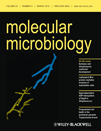- Submit a Protocol
- Receive Our Alerts
- Log in
- /
- Sign up
- My Bio Page
- Edit My Profile
- Change Password
- Log Out
- EN
- EN - English
- CN - 中文
- Protocols
- Articles and Issues
- For Authors
- About
- Become a Reviewer
- EN - English
- CN - 中文
- Home
- Protocols
- Articles and Issues
- For Authors
- About
- Become a Reviewer
Promoter Orientation of Prokaryotic Phase-variable Genes by PCR
Published: Vol 2, Iss 20, Oct 20, 2012 DOI: 10.21769/BioProtoc.274 Views: 10601

Protocol Collections
Comprehensive collections of detailed, peer-reviewed protocols focusing on specific topics
Related protocols

Protocol to Retrieve Unknown Flanking DNA Using Fork PCR for Genome Walking
Hongjing Wu [...] Haixing Li
Jan 20, 2025 2341 Views
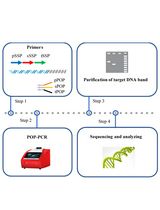
Protocol to Identify Unknown Flanking DNA Using Partially Overlapping Primer-based PCR for Genome Walking
Mengya Jia [...] Haixing Li
Feb 5, 2025 1309 Views
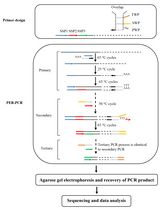
Protocol to Mine Unknown Flanking DNA Using PER-PCR for Genome Walking
Zhou Yu [...] Haixing Li
Feb 20, 2025 1441 Views
Abstract
One major mechanism of phase variable gene expression in prokaryotes is through inversion of the promoter element for a gene or operon. This protocol describes how to detect the promoter orientation of a phase-variable gene by PCR. This protocol, including primer design, is specific to detection of the promoter orientations of hyxR, a LuxR-like response regulator in Extraintestinal Pathogenic Escherichia coli (ExPEC) isolates (Bateman and Seed, 2012); however, this protocol can be generalized to other organisms and genes to discriminate prokaryotic promoter inversions by PCR through size discrimination of the amplification products. Expression of hyxR is regulated through bidirectional phase inversion of the upstream promoter region mediated by a member of the family of site-specific tyrosine recombinases called Fim-like recombinases. The recombinases recognize inverted DNA repeat sequences flanking the promoter and produce a genomic rearrangement, orientating the promoter in favor or disfavor of gene expression.
Materials and Reagents
- Escherichia coli (E. coli) isolate UTI893
- Sterile distilled, deionized water (diH2O)
- Agarose, molecular biology grade, standard sieve
- Ethidium Bromide, 1 mg/ml in distilled, deionized water (diH2O) (or other agent to visualize DNA)
- Taq polymerase (1 U/μl) with 10x NH4 buffer (APEX Bioresearch Products, catalog number: 42-409 )
- 10 mM dNTP mix, PCR grade (Life Technologies, catalog number: 18427-013 )
- Tryptone
- Yeast extract
- NaCl
- Tris base
- Boric acid
- EDTA (pH 8.0)
- SDS
- Glycerol
- Xylene cyanol
- Bromophenol blue
- hyxR phase-specific primers, 100 μM stock solution [Integrated DNA Technologies (IDT)]
5’ – ACTGATAATAACCAGAGGCTTCTT – 3’
5’ – CAGTGATTAACTTTCGAACATATTG – 3’
5’ – GCGAAAGTTAATCACTGGTATGACC – 3’ - Tris-Borate-EDTA (TBE) (10x stock) (see Recipes)
- 10x DNA Loading Dye (see Recipes)
- Luria-Bertani broth (LB) culture medium (Sigma-Aldrich, catalog number: L3022-250G (see Recipes)
- 2% TBE agarose gel with EtBr (see Recipes)
- 20 ml 10x DNA Loading dye6 (xylene cyanol/bromophenol blue) (see Recipes)
Equipment
- 37 °C Incubator for bacteria with aeration
- Thermal cycler (Bio-Rad Laboratories)
- Gel electrophoresis system (Owl Separation Systems)
- UV Transilluminator with photo documentation (Bio-Rad Laboratories)
Procedure
- Start 5 ml overnight culture of E. coli isolate UTI89 (Note 1) in LB at 37 °C with aeration. Culture can be started from a colony on an agar plate or from a -80 °C glycerol stock.
- Setting up the phase-PCR reaction
- Phase PCR was performed using a 1:1:1 mixture of 3 phase primers including 1) an anchor primer outside of the invertible region (primer 1); 2) a phase-specific primer for the OFF orientation (primer 2); and 3) a phase-specific primer for the ON orientation (primer 3).
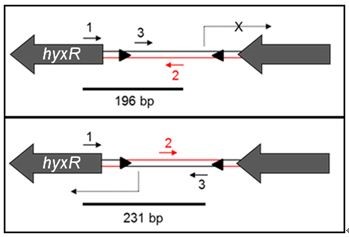
Reaction mixture (Note 2)
1 μl overnight bacterial culture (template)
2.5 μl of 10x APEX NH4 buffer (1x final concentration)
0.5 μl of 1 unit/μl APEX Taq polymerase (0.5 unit final concentration)
1.25 μl of 50 mM MgCl2 (2.5 mM final concentration)
0.1 μl of 100 μM stock of each of 3 primers (0.4 μM final concentration of each primer)
0.5 μl of 10 mM dNTP mix (0.2 mM final concentration)
up to 25 μl total volume with sterile diH2O. - Thermal cycler program:
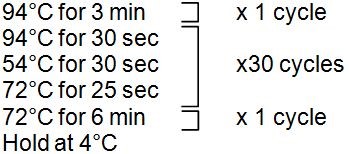
- Phase PCR was performed using a 1:1:1 mixture of 3 phase primers including 1) an anchor primer outside of the invertible region (primer 1); 2) a phase-specific primer for the OFF orientation (primer 2); and 3) a phase-specific primer for the ON orientation (primer 3).
- Make 50 ml volume of 2% agarose in 1x TBE (see below). Pour gel into casting apparatus.
- Cover gel completely with 1x TBE (running buffer).
- Mix 5-10 μl of PCR reaction with 0.5-1.0 μl 10x DNA loading dye (approx. 1x final concentration). Load into wells and run samples at 100-120 V for 45 min to 1 h.
- Visualize and photograph using a UV gel transilluminator.
- Mixed phase populations show two bands by PCR, corresponding to the OFF and ON promoter orientations. The OFF orientation gives a 196 bp amplicon vs. a 231 bp amplicon for the ON orientation.
Notes
- UTI89 is a prototypic ExPEC cystitis isolate that was obtained from an adult patient with cystitis and has been well described in the literature (Mulvey, 1998). Primers for this protocol were designed to UTI89 genomic sequence, and while ExPEC isolates are similar, their genomic sequence may not be exact. It is recommended that researchers check that the primers listed in this protocol will work with other ExPEC isolates.
- All PCR reactions were performed using APEX Taq polymerase and accompanying buffers distributed by Genesse Scientific, Inc (San Diego, California, USA). Thermal cycler parameters were based on the manufacturer’s recommendations. Taq polymerase or related thermostable polymerases would be expected to provide similar performance in this assay with minor modifications of the reactions.
- 1x TBE is what you will use to make your agarose gel as well as the buffer used to run the gel.
- Any commercially available DNA loading dye is appropriate. The recipe given is only a home-made suggestion. Other recipes available use different tracking dyes and/or density agents.
Recipes
- 1x LB
Suspend 20 g in 1 L of distilled water
Autoclave for 15 min at 121 °C
Final concentration of components (Tryptone 10 g/L, yeast extract 5 g/L, NaCl 5 g/L) - 1 L 10x TBE buffer stock (Tris-borate-EDTA)
108 g Tris base
55 g Boric acid
40 ml 0.5 M EDTA (pH 8.0)
diH2O to 1 L
Stir until completely dissolved - 1 L 1x TBE buffer (working) (Note 3)
100 ml 10x TBE
900 ml diH2O
Mix well - 2% TBE agarose gel with EtBr
2 g agarose per 100 ml 1x TBE
Heat in microwave (approx. 2 min) until agarose is dissolved
Let stand at room temperature for 15-20 min to cool (you do not want to re-solidify)
Add EtBr to a final concentration of 0.1 μg/ml just prior to pouring gel - 20 ml 10x DNA Loading dye (Note 4) (xylene cyanol/bromophenol blue)
Add 0.025 g each xylene cyanol and bromophenol blue
1.25 ml 10% SDS
12.5 ml 100% glycerol
6.25 ml H2O
Mix thoroughly and store at room temperature
Acknowledgments
This protocol is adapted from Bateman and Seed (2012).
References
- Bateman, S. L. and Seed, P. C. (2012). Epigenetic regulation of the nitrosative stress response and intracellular macrophage survival by extraintestinal pathogenic Escherichia coli. Mol Microbiol 83(5): 908-925.
- Mulvey, M. A., Lopez-Boado, Y. S., Wilson, C. L., Roth, R., Parks, W. C., Heuser, J. and Hultgren, S. J. (1998). Induction and evasion of host defenses by type 1-piliated uropathogenic Escherichia coli. Science 282(5393): 1494-1497.
Article Information
Copyright
© 2012 The Authors; exclusive licensee Bio-protocol LLC.
How to cite
Bateman, S. L. and Seed, P. (2012). Promoter Orientation of Prokaryotic Phase-variable Genes by PCR. Bio-protocol 2(20): e274. DOI: 10.21769/BioProtoc.274.
Category
Microbiology > Microbial genetics > DNA > PCR
Molecular Biology > DNA > PCR
Do you have any questions about this protocol?
Post your question to gather feedback from the community. We will also invite the authors of this article to respond.
Share
Bluesky
X
Copy link


